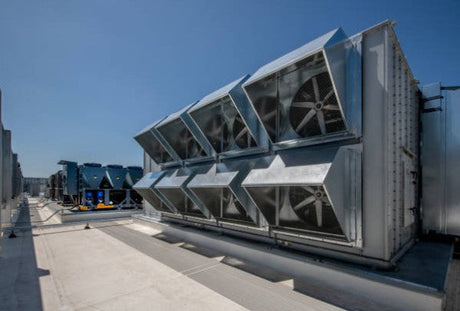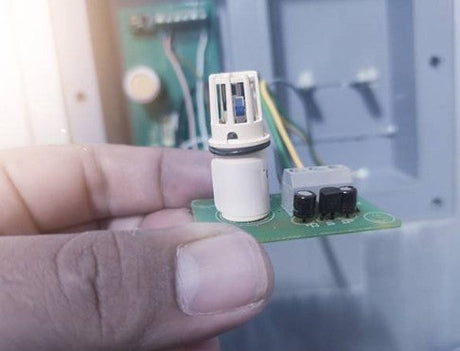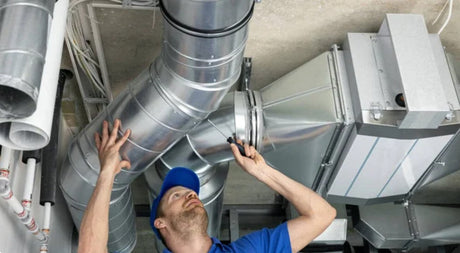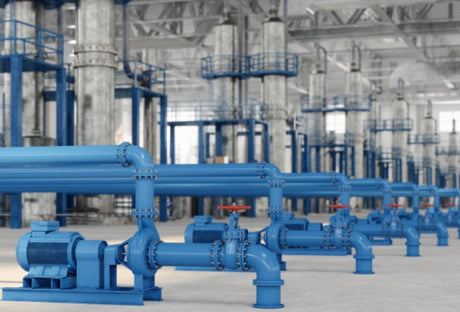The magnetically inductive flow measurement is a common method to measure the speed of conductive liquids in closed pipes. It is used in many branches of industry because it works without contact and therefore without wear. In the following, we explain the functionality of the magnetically inductive flow measurement, explain your areas of application and give tips on what you should take into account when buying such a measuring device.
Magnetically inductive flow meter: its functionality
The inductive flow measurement is based on Faraday's law of electromagnetic induction. This states that in an electrical conductor that moves within a magnetic field and cuts the magnetic field lines, a voltage is induced. When measuring the flow, the liquid to be measured acts as an electrical conductor, while the magnetic field is generated by electromagnet that are located outside the measuring tube.
Magnetically inductive flow meter: its structure
The measuring tube is typically coated with a non-conductive material to ensure that only the liquid is influenced by the magnetic field. Electrodes are attached to two points of the tube, which are perpendicular to the magnetic field and the flow path of the liquid. If a conductive liquid flows through the pipe, a tension on the electrodes is induced according to Faraday’s law. This voltage is proportional to the speed of the liquid and thus to the Volume flow.
Magnetically inductive flow meter: its function
Magnetic inductive Floor measuring devices Due to their non-invasive measurement methodology, are particularly advantageous in many areas of application. In contrast to invasive procedures, in which sensors or measuring devices come into contact directly with the liquid to be measured, the magnetically inductive technology measures the flow through the tube without penetrating it and without components to lead them into the liquid flow.
Advantages of magnetically inductive flow measurement:
- No impairment of the medium: Since no parts of the measuring device intervene in the liquid, there is no risk of contamination or influencing the medium. This is particularly critical in the food, beverage and pharmaceutical industry, where purity is essential.
- Reduced maintenance effort: A magnetic inductive flow measurement is largely maintenance -free, since there are no moving parts that can come into contact with the process medium and wear it out. This reduces the maintenance effort and maintenance costs.
- Higher reliability: A non-invasive measurement method minimizes the risk of failures due to wear or deposits, which, for example, often occur in mechanical flow meters.
- Easy installation and operation: The installation of the magnetically inductive flow measurement is uncomplicated because no complex interventions in the pipe system are necessary. This enables them to be integrated into existing systems even more easily.
- Application in aggressive media: Since the measuring device itself does not come into contact with the liquid, the magnetically inductive flow measurement can also be used in aggressive, corrosive or high -purity media without material fatigue being a problem.
The non-invasive nature of magnetically inductive flow measurement makes it an ideal choice for a variety of industrial applications in which reliability, hygiene and low maintenance are the top priority.
Areas of application of the magnetically inductive flow measurement
The magnetically inductive flow measurement is ideal for liquids with a certain minimum guideline, as often occur in the following areas:
- Water treatment and wastewater treatment
- Chemical and pharmaceutical industry
- Food and beverage industry
- Power plants and mining
- Paper and pulp industry
This technology is often used if it is necessary to measure the flow rate of aggressive media or dirt -controlled liquids, since no moving parts come into contact with the measurement medium and therefore do not occur.
What should be observed before buying a magnetically inductive flow measuring device
- Liberty of the liquid: Not every liquid is suitable for the magnetically inductive flow measurement. The liquid must have sufficient electrical conductivity. Distilled water or oils are not measurable, for example. Check the conductivity of your liquid before deciding on a measuring device.
- Material of the measuring tube and the electrodes: The material of the measuring tube must be chemically resistant to the liquid to be measured. Likewise, the electrodes and the lining of the measuring tube must be selected so that they are not damaged by the liquid.
- Size and installation: The dimensioning of the measuring device should be adapted to the pipeline to ensure precise measurements. Pay attention to the manufacturer's information regarding the minimal and maximum flow speeds as well as the installation conditions, such as the need for straight enema and outlet routes.
- Temperature and pressure conditions: Make sure that the measuring device is suitable for the temperature and pressure conditions of the application. Extreme conditions can require special designs of the devices.
- Integration into existing systems: Another important point is the compatibility of the magnetically inductive flow measuring device with the existing measurement technology and control technology in your company. Find out more about interfaces and communication protocols.
- Certifications and norms: Certifications and compliance with certain standards may be necessary for some applications, for example in the food and beverage industry or in the area of explosive atmospheres. For these cases we offer special Ex-protected devices to.
The magnetically inductive flow measurement offers a reliable and precise solution for volume current measurement in many industrial processes. However, in order to select a suitable measuring device, it is important to take into account the specific requirements of your application and, if necessary, obtain expert advice. We are happy to stand With more than 30 years of experience in the field of industrial flow measurement. If you have any questions, contact our experts for Measurement and control technology. Or look for a quick overview of our counselor.
Innovative solutions from Seikom Electronic
Seickom Electronic offers with the RLSWR8 volume stream device A proven solution to the Calorimetric volume current measurement. The RLSWR8 is available in different versions and is therefore optimally adjustable for different industrial applications. The standard version for media up to 80 ° C is suitable, while the specially developed variant enables the measurement of media up to 350 ° C. You are also welcome to watch our other products from the category Volume stream units to.






